Rui Cai
Diagnosing and Mitigating Modality Interference in Multimodal Large Language Models
May 26, 2025Abstract:Multimodal Large Language Models (MLLMs) have demonstrated impressive capabilities across tasks, yet they often exhibit difficulty in distinguishing task-relevant from irrelevant signals, particularly in tasks like Visual Question Answering (VQA), which can lead to susceptibility to misleading or spurious inputs. We refer to this broader limitation as the Cross-Modality Competency Problem: the model's inability to fairly evaluate all modalities. This vulnerability becomes more evident in modality-specific tasks such as image classification or pure text question answering, where models are expected to rely solely on one modality. In such tasks, spurious information from irrelevant modalities often leads to significant performance degradation. We refer to this failure as Modality Interference, which serves as a concrete and measurable instance of the cross-modality competency problem. We further design a perturbation-based causal diagnostic experiment to verify and quantify this problem. To mitigate modality interference, we propose a novel framework to fine-tune MLLMs, including perturbation-based data augmentations with both heuristic perturbations and adversarial perturbations via Projected Gradient Descent (PGD), and a consistency regularization strategy applied to model outputs with original and perturbed inputs. Experiments on multiple benchmark datasets (image-heavy, text-heavy, and VQA tasks) and multiple model families with different scales demonstrate significant improvements in robustness and cross-modality competency, indicating our method's effectiveness in boosting unimodal reasoning ability while enhancing performance on multimodal tasks.
Boosting Knowledge Graph-based Recommendations through Confidence-Aware Augmentation with Large Language Models
Feb 06, 2025



Abstract:Knowledge Graph-based recommendations have gained significant attention due to their ability to leverage rich semantic relationships. However, constructing and maintaining Knowledge Graphs (KGs) is resource-intensive, and the accuracy of KGs can suffer from noisy, outdated, or irrelevant triplets. Recent advancements in Large Language Models (LLMs) offer a promising way to improve the quality and relevance of KGs for recommendation tasks. Despite this, integrating LLMs into KG-based systems presents challenges, such as efficiently augmenting KGs, addressing hallucinations, and developing effective joint learning methods. In this paper, we propose the Confidence-aware KG-based Recommendation Framework with LLM Augmentation (CKG-LLMA), a novel framework that combines KGs and LLMs for recommendation task. The framework includes: (1) an LLM-based subgraph augmenter for enriching KGs with high-quality information, (2) a confidence-aware message propagation mechanism to filter noisy triplets, and (3) a dual-view contrastive learning method to integrate user-item interactions and KG data. Additionally, we employ a confidence-aware explanation generation process to guide LLMs in producing realistic explanations for recommendations. Finally, extensive experiments demonstrate the effectiveness of CKG-LLMA across multiple public datasets.
Dynamic Adapter with Semantics Disentangling for Cross-lingual Cross-modal Retrieval
Dec 18, 2024



Abstract:Existing cross-modal retrieval methods typically rely on large-scale vision-language pair data. This makes it challenging to efficiently develop a cross-modal retrieval model for under-resourced languages of interest. Therefore, Cross-lingual Cross-modal Retrieval (CCR), which aims to align vision and the low-resource language (the target language) without using any human-labeled target-language data, has gained increasing attention. As a general parameter-efficient way, a common solution is to utilize adapter modules to transfer the vision-language alignment ability of Vision-Language Pretraining (VLP) models from a source language to a target language. However, these adapters are usually static once learned, making it difficult to adapt to target-language captions with varied expressions. To alleviate it, we propose Dynamic Adapter with Semantics Disentangling (DASD), whose parameters are dynamically generated conditioned on the characteristics of the input captions. Considering that the semantics and expression styles of the input caption largely influence how to encode it, we propose a semantic disentangling module to extract the semantic-related and semantic-agnostic features from the input, ensuring that generated adapters are well-suited to the characteristics of input caption. Extensive experiments on two image-text datasets and one video-text dataset demonstrate the effectiveness of our model for cross-lingual cross-modal retrieval, as well as its good compatibility with various VLP models.
Zero-Shot Relational Learning for Multimodal Knowledge Graphs
Apr 09, 2024Abstract:Relational learning is an essential task in the domain of knowledge representation, particularly in knowledge graph completion (KGC).While relational learning in traditional single-modal settings has been extensively studied, exploring it within a multimodal KGC context presents distinct challenges and opportunities. One of the major challenges is inference on newly discovered relations without any associated training data. This zero-shot relational learning scenario poses unique requirements for multimodal KGC, i.e., utilizing multimodality to facilitate relational learning. However, existing works fail to support the leverage of multimodal information and leave the problem unexplored. In this paper, we propose a novel end-to-end framework, consisting of three components, i.e., multimodal learner, structure consolidator, and relation embedding generator, to integrate diverse multimodal information and knowledge graph structures to facilitate the zero-shot relational learning. Evaluation results on two multimodal knowledge graphs demonstrate the superior performance of our proposed method.
Masked Face Dataset Generation and Masked Face Recognition
Nov 13, 2023



Abstract:In the post-pandemic era, wearing face masks has posed great challenge to the ordinary face recognition. In the previous study, researchers has applied pretrained VGG16, and ResNet50 to extract features on the elaborate curated existing masked face recognition (MFR) datasets, RMFRD and SMFRD. To make the model more adaptable to the real world situation where the sample size is smaller and the camera environment has greater changes, we created a more challenging masked face dataset ourselves, by selecting 50 identities with 1702 images from Labelled Faces in the Wild (LFW) Dataset, and simulated face masks through key point detection. The another part of our study is to solve the masked face recognition problem, and we chose models by referring to the former state of the art results, instead of directly using pretrained models, we fine tuned the model on our new dataset and use the last linear layer to do the classification directly. Furthermore, we proposed using data augmentation strategy to further increase the test accuracy, and fine tuned a new networks beyond the former study, one of the most SOTA networks, Inception ResNet v1. The best test accuracy on 50 identity MFR has achieved 95%.
Cross-Lingual Cross-Modal Retrieval with Noise-Robust Learning
Aug 26, 2022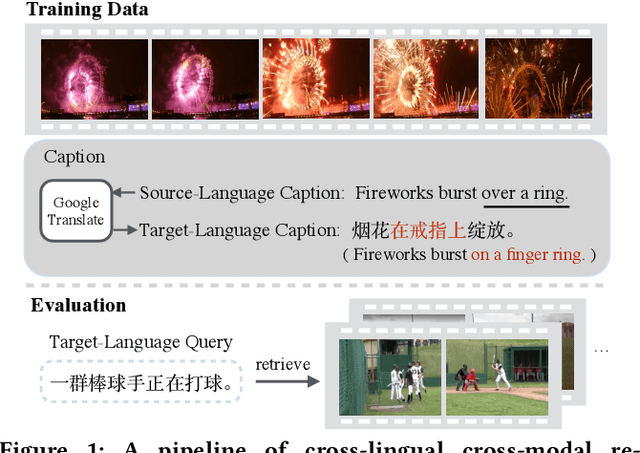
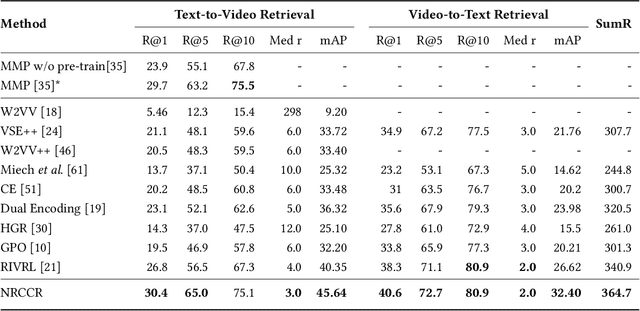
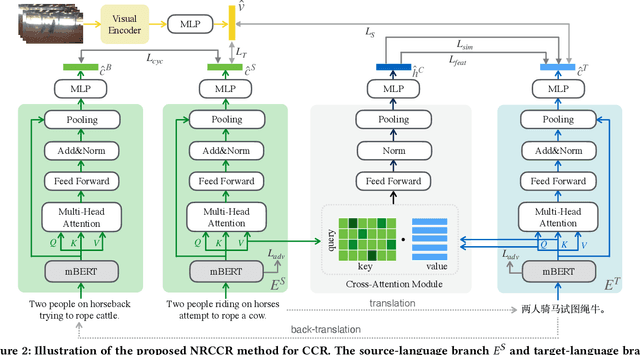
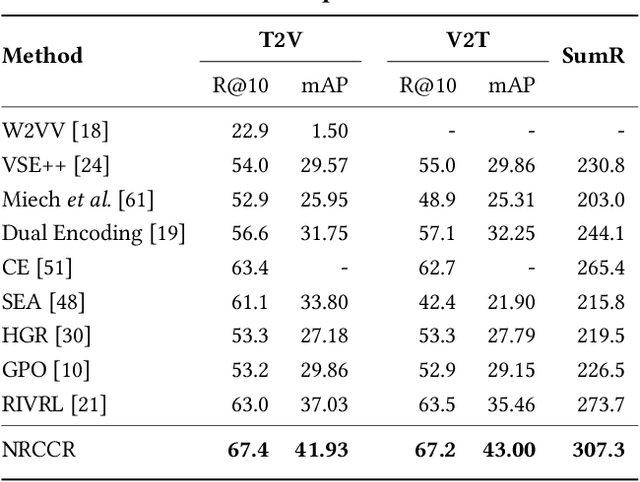
Abstract:Despite the recent developments in the field of cross-modal retrieval, there has been less research focusing on low-resource languages due to the lack of manually annotated datasets. In this paper, we propose a noise-robust cross-lingual cross-modal retrieval method for low-resource languages. To this end, we use Machine Translation (MT) to construct pseudo-parallel sentence pairs for low-resource languages. However, as MT is not perfect, it tends to introduce noise during translation, rendering textual embeddings corrupted and thereby compromising the retrieval performance. To alleviate this, we introduce a multi-view self-distillation method to learn noise-robust target-language representations, which employs a cross-attention module to generate soft pseudo-targets to provide direct supervision from the similarity-based view and feature-based view. Besides, inspired by the back-translation in unsupervised MT, we minimize the semantic discrepancies between origin sentences and back-translated sentences to further improve the noise robustness of the textual encoder. Extensive experiments are conducted on three video-text and image-text cross-modal retrieval benchmarks across different languages, and the results demonstrate that our method significantly improves the overall performance without using extra human-labeled data. In addition, equipped with a pre-trained visual encoder from a recent vision-and-language pre-training framework, i.e., CLIP, our model achieves a significant performance gain, showing that our method is compatible with popular pre-training models. Code and data are available at https://github.com/HuiGuanLab/nrccr.
Regularized Discriminant Embedding for Visual Descriptor Learning
Jan 16, 2013
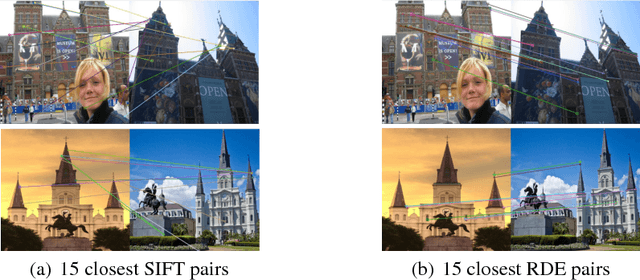
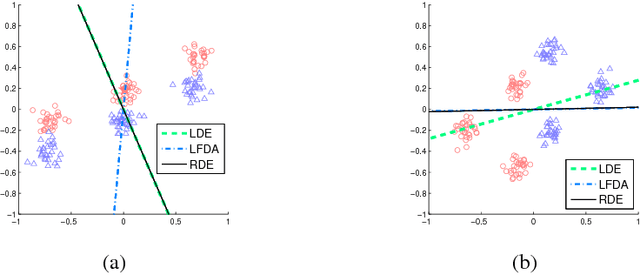

Abstract:Images can vary according to changes in viewpoint, resolution, noise, and illumination. In this paper, we aim to learn representations for an image, which are robust to wide changes in such environmental conditions, using training pairs of matching and non-matching local image patches that are collected under various environmental conditions. We present a regularized discriminant analysis that emphasizes two challenging categories among the given training pairs: (1) matching, but far apart pairs and (2) non-matching, but close pairs in the original feature space (e.g., SIFT feature space). Compared to existing work on metric learning and discriminant analysis, our method can better distinguish relevant images from irrelevant, but look-alike images.
 Add to Chrome
Add to Chrome Add to Firefox
Add to Firefox Add to Edge
Add to Edge